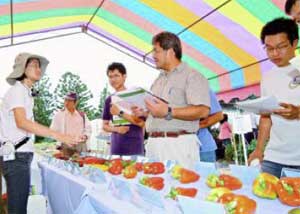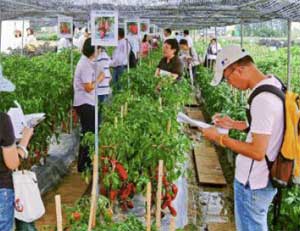Tainan, Taiwan
June 12, 2009
Source:
AVRDC - The World Vegetable
Center - Newsletter
CMS: How sweet it is
 Often
used with hot peppers for F1 hybrid seed production, cytoplasmic
male sterility or CMS can reduce production costs by as much as
47 percent. The technique is a valuable tool for the vegetable
seed industry, where CMS is used to rapidly combine traits and
protect proprietary lines. Often
used with hot peppers for F1 hybrid seed production, cytoplasmic
male sterility or CMS can reduce production costs by as much as
47 percent. The technique is a valuable tool for the vegetable
seed industry, where CMS is used to rapidly combine traits and
protect proprietary lines.
CMS lines in peppers are often unstable under low temperatures,
and thus had limited applications. CMS in sweet pepper is also
limited by a lack of fertility restorer parents, whose genetic
contribution reverses the sterile status of the female parent.
Pepper breeders at AVRDC – The World Vegetable Center took on
the challenge and worked for more than a decade to develop
methods and materials for cytoplasmic male sterility (CMS) in
both hot and sweet peppers. To date, the breeding program has
made available more than 20 sterile lines and their maintainers.
The success of their long effort was showcased in a workshop
held on 4 June at AVRDC headquarters in Taiwan. More than 60
representatives from Taiwan’s seed industry, universities, and
government agricultural research
stations including the Taiwan Agriculture Research Institute,
District Agricultural Research and Extension Stations, and the
Taiwan Seed Station attended the event. Dr. Paul Gniffke,
head of the Center’s pepper breeding unit,
recapped the history of CMS breeding at AVRDC, which began with
a grant from the Seminis Seed Company and continues with support
from the Taiwan Council of Agriculture.
 Commercial
production of hybrids is feasible only if a reliable and
cost-effective pollination control system is available. During
hybrid seed production, several methods can be used to prevent
selfpollination of the female line, including removing the
anthers or male flowers by hand or machine, applying
male-specific gametocides, or employing cytoplasmic or genic
male sterility systems. Cytoplasmic male-sterile lines have a
mutation in their Commercial
production of hybrids is feasible only if a reliable and
cost-effective pollination control system is available. During
hybrid seed production, several methods can be used to prevent
selfpollination of the female line, including removing the
anthers or male flowers by hand or machine, applying
male-specific gametocides, or employing cytoplasmic or genic
male sterility systems. Cytoplasmic male-sterile lines have a
mutation in their
mitochondrial genome, and the male sterility is inherited as a
maternally transmitted trait. Fertility can be restored through
a dominant allele in a normally inherited nuclear gene.
As Principal Research Assistant Jin Shieh told the
audience, cytoplasmic male sterility can be used for hybrid
sweet pepper seed production only if a CMS mutant is available
and restorer genes are available to restore fertility in the
hybrid variety for normal fruit development. She provided
evidence that in some cases, fertility restoration is controlled
by two loci (fixed positions on a chromosome). Principal
Research Assistant Susan Lin reviewed AVRDC’s
accomplishments in addressing low temperature instability of
sterility in sweet pepper, the identification of effective
restorer lines, and the use of honeybees to save labor. Prof.
Wen-Ju Yang of National Taiwan University confirmed the
utility of molecular markers associated with mitochondrial
factors and nuclear
genes in AVRDC’s CMS lines. Although the marker associated
with fertility restoration in hot peppers worked for some sweet
peppers, it failed to identify restorers in other cases—a
possible indication that different (or additional) genes
condition CMS in sweet pepper.
The presentations were followed by a tour of a field
demonstration of several CMS sweet pepper hybrid
combinations using AVRDCdeveloped parents, and a comparison of
hybrids using CMS sterile parents vs. hybrids
generated with related maintainer lines. Cages for bee-mediated
crosspollination and seed production were also displayed.
Participants received seed samples of some lines and will report
the results of their own trials. Comments from participants were
generally positive, and the Center’s continued effort to advance
CMS in sweet
pepper was encouraged.
At the AVRDC Library:
Cytoplasmic Male
Sterility in Sweet Pepper to Produce Hybrid Seed
PA Gniffke, SW Lin and SC Shieh
http://libnets.avrdc.org.tw/fulltext_pdf/eb0108.pdf
|
|